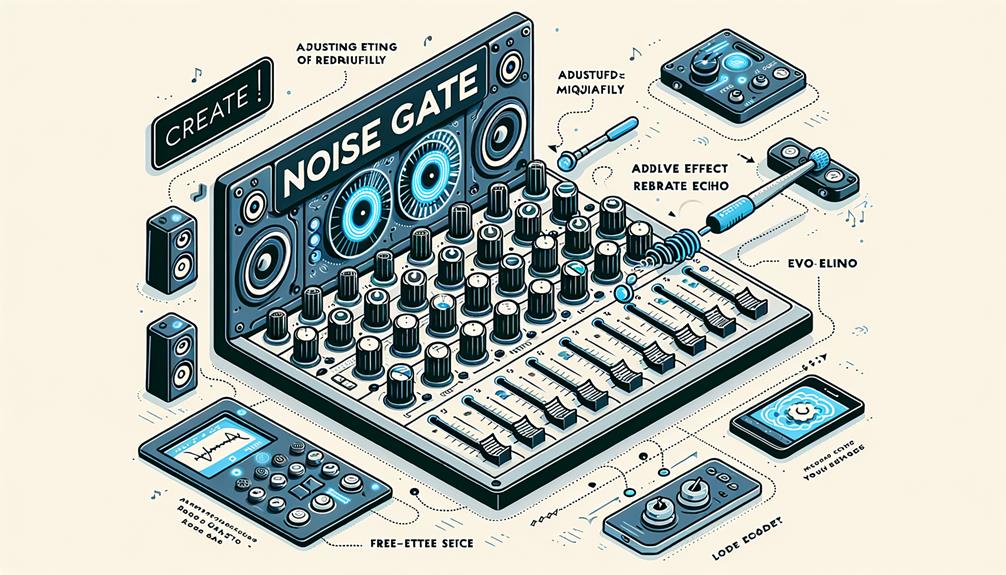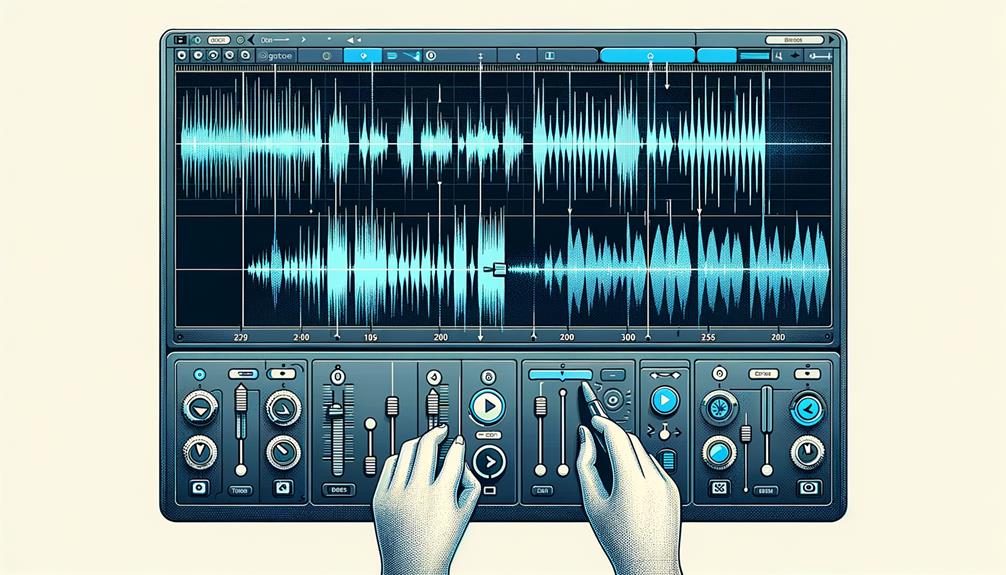No products in the cart.
Are you tired of dealing with that pesky echo in your audio recordings? It can be frustrating to have a great recording ruined by unwanted reverberation.
Luckily, there are effective techniques in Audacity that can help you tackle this issue. From using the Noise Reduction effect to fine-tuning the audio, there are several methods to explore.
But how exactly do you go about identifying the best approach for your specific recording? Keep reading to discover the step-by-step process and gain valuable insights into removing echo in Audacity.
Contents
hide
Key Takeaways
- Identifying and addressing the echo issue is crucial for audio clarity in recordings.
- Utilize the Noise Reduction effect in Audacity by selecting the track with echo or background noise, obtaining a noise profile, and adjusting reduction values and frequency smoothing.
- Apply the Noise Gate tool to reduce residual noise and attenuate echo by adjusting the gate threshold, gate frequencies, and level reduction settings.
- The Dereverb effect can be used to eliminate echo and reverberation in audio recordings, with customization options available in both automatic and expert mode.
Identifying the Echo Issue
When identifying the echo issue in your recordings, listen attentively for the delayed and repeated sound that may impact the overall audio quality. Echo reduction is essential for maintaining the clarity and professionalism of your original audio recordings.
In Audacity, identifying echo issues involves using noise reduction and high-pass filters to isolate and remove unwanted echoes. The process begins by carefully analyzing the audio waveform for instances of delayed sound. Pay close attention to segments where the speaker’s voice is followed by a discernible repetition at a short time interval. This often occurs in larger spaces like a conference room, where sound reflections are more pronounced.
Once the echo issue is identified, Audacity provides precise tools for removing echo while preserving the integrity of the original audio recording. By employing effective echo reduction techniques, you can ensure that your audio recordings are free from unwanted reverberations, creating a pristine and professional listening experience for your audience.
Using Noise Reduction Effect
To address the echo issue identified in your recordings, you can utilize the Noise Reduction effect in Audacity to diminish persistent background noises such as hums, whistles, and hisses. Follow these steps to effectively use the Noise Reduction effect:
- Select the track containing the echo or background noise in your Audacity project.
- Go to the ‘Effect’ menu, choose ‘Noise Reduction,’ and click on ‘Get Noise Profile.’
- Once you have the noise profile, select the entire track, go back to the ‘Effect’ menu, choose ‘Noise Reduction’ again, and adjust the reduction values and frequency smoothing to reduce the background noise.
Applying Noise Gate

Consider applying a Noise Gate to your audio recordings in Audacity to effectively reduce residual noise intervals and attenuate echo. A Noise Gate acts as an electronic gatekeeper, allowing audio to pass only when it reaches a certain threshold, effectively reducing background noise and echo in the process. By adjusting the Gate Threshold, Gate Frequencies, and Level Reduction settings, you can fine-tune the Noise Gate effect to suit your specific audio recording and effectively diminish echo.
| Setting | Description |
|---|---|
| Gate Threshold | Determines the level at which the gate opens to allow audio through, effectively reducing background noise. |
| Gate Frequencies | Controls the range of frequencies affected by the gate, helping to attenuate echo and residual noise. |
| Level Reduction | Adjusts the amount by which the audio is reduced when below the Gate Threshold, further reducing echo. |
Experimenting with these settings can enhance the Noise Gate’s effectiveness in reducing echo and improving the overall audio quality of your recordings. By applying Noise Gate in Audacity, you can customize and optimize the noise reduction effect to effectively diminish echo in your audio recordings.
Utilizing Dereverb
To build on the reduction of echo and reverberation, you can further enhance your audio recordings in Audacity by effectively utilizing the Dereverb feature. Dereverb in Audacity offers a powerful toolset to eliminate echo and reverberation, providing a more professional sound to your audio recordings.
Here’s how you can effectively utilize Dereverb:
- Customize Dereverb Settings: Adjust the parameters of the Dereverb effect in Audacity to precisely control reverb reduction for each frequency band, ensuring that the echo effect is removed without compromising the audio quality.
- Automatic Gate Threshold Estimation: Dereverb automatically estimates gate thresholds based on frequency bands, reducing the need for manual adjustments and streamlining the noise reduction process, especially in environments such as conference rooms with background noise.
- Fine-tune Dereverb Profile: Fine-tune the Dereverb profile using Sensitivity and Threshold offset, and customize settings in Expert mode to further enhance the echo removal process, ensuring that the audio recording is free from unwanted reverberations and echoes.
Fine-Tuning the Audio


Fine-tune your audio recordings in Audacity by experimenting with tools like Noise Reduction, Equalization, High Pass filter, and the DeReverb effect to effectively eliminate echo.
When using the Noise Reduction effect, adjust the reduction values and frequency smoothing to reduce echo without affecting the audio quality.
In Audacity, the Noise Gate feature allows you to fine-tune the audio by customizing settings such as Gate Threshold and Level Reduction to effectively reduce the echo.
Additionally, the Equalization tool can be used to adjust the frequency response and reduce unwanted background noise, contributing to echo removal.
Consider using the High Pass filter to attenuate frequencies below a certain cutoff, which can help reduce the presence of low-frequency echo.
When employing the DeReverb effect, precise control over reverb reduction for each frequency band allows for fine-tuning to remove echo from specific frequency ranges.
Experiment with these tools and their customizable parameters to achieve optimal results in reducing echo and enhancing the quality of your audio recordings in Audacity.
Frequently Asked Questions
Is There a Way to Remove Echo in Audacity?
Yes, you can remove echo in Audacity by using echo reduction and noise removal techniques. Consider acoustic treatment, sound isolation, and room acoustics for audio enhancement. Utilize reverb control and echo cancellation during audio editing for optimal results.
How Do I Remove Echo From Audio?
To reduce echo in audio, try various echo reduction techniques, noise cancellation tips, and audio enhancement methods. Experiment with echo removal software and sound editing tricks. Utilize recording quality improvement and voice cleanup methods for improved audio.
How Do I Clean My Voice in Audacity?
To improve your voice in Audacity, utilize noise reduction, audio editing, and post production techniques. Enhance vocal clarity and reduce echo for sound improvement. Experiment with recording cleanup and audio restoration to achieve the desired results.
How to Do an Echo Fade in Audacity?
To achieve an echo fade in Audacity, adjust the fade in/out effect to smoothly introduce or remove echo. Experiment with different settings and techniques like noise reduction, gate threshold, and level reduction for sound improvement and quality enhancement.
Conclusion
After identifying the echo issue, utilize Audacity’s Noise Reduction effect, Noise Gate, and Dereverb to effectively remove echo.
Fine-tune the audio by adjusting parameters and experimenting with different techniques.
With knowledge and skills in audio editing, echo can be eliminated to improve the overall audio quality.
Practice and patience are key in mastering the art of removing echo in Audacity.




